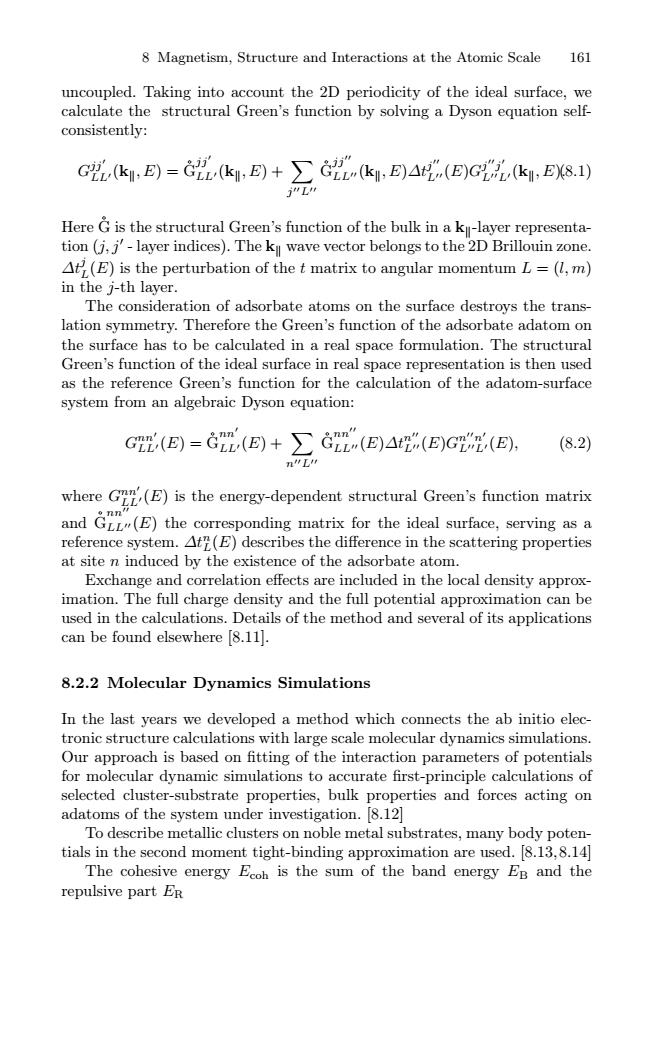正在加载图片...

8 Magnetism,Structure and Interactions at the Atomic Scale 161 uncoupled.Taking into account the 2D periodicity of the ideal surface,we calculate the structural Green's function by solving a Dyson equation self- consistently: ()(+)(E)G EX8.1) j"L Here G is the structural Green's function of the bulk in a k-layer representa- tion(j,j-layer indices).The k wave vector belongs to the 2D Brillouin zone. △t,(E)is the perturbation of the t matrix to angular momentum L=(亿,m) in the j-th layer. The consideration of adsorbate atoms on the surface destroys the trans- lation symmetry.Therefore the Green's function of the adsorbate adatom on the surface has to be calculated in a real space formulation.The structural Green's function of the ideal surface in real space representation is then used as the reference Green's function for the calculation of the adatom-surface system from an algebraic Dyson equation: G(E)=Gt(E)+∑G2(E)4t%(E)G院(E, (8.2) n"Eu where G(E)is the energy-dependent structural Green's function matrix onn and GLL(E)the corresponding matrix for the ideal surface,serving as a reference system.At(E)describes the difference in the scattering properties at site n induced by the existence of the adsorbate atom. Exchange and correlation effects are included in the local density approx- imation.The full charge density and the full potential approximation can be used in the calculations.Details of the method and several of its applications can be found elsewhere [8.11]. 8.2.2 Molecular Dynamics Simulations In the last years we developed a method which connects the ab initio elec- tronic structure calculations with large scale molecular dynamics simulations. Our approach is based on fitting of the interaction parameters of potentials for molecular dynamic simulations to accurate first-principle calculations of selected cluster-substrate properties,bulk properties and forces acting on adatoms of the system under investigation.8.12 To describe metallic clusters on noble metal substrates,many body poten- tials in the second moment tight-binding approximation are used.[8.13,8.14] The cohesive energy Ecoh is the sum of the band energy EB and the repulsive part ER8 Magnetism, Structure and Interactions at the Atomic Scale 161 uncoupled. Taking into account the 2D periodicity of the ideal surface, we calculate the structural Green’s function by solving a Dyson equation selfconsistently: Gjj LL (k , E) = G˚jj LL (k , E) + jL G˚jj LL (k , E)∆tj L (E)Gjj LL (k , E)(8.1) . Here G is the structural Green’s function of the bulk in a ˚ k -layer representation (j, j - layer indices). The k wave vector belongs to the 2D Brillouin zone. ∆tj L(E) is the perturbation of the t matrix to angular momentum L = (l, m) in the j-th layer. The consideration of adsorbate atoms on the surface destroys the translation symmetry. Therefore the Green’s function of the adsorbate adatom on the surface has to be calculated in a real space formulation. The structural Green’s function of the ideal surface in real space representation is then used as the reference Green’s function for the calculation of the adatom-surface system from an algebraic Dyson equation: Gnn LL (E) = G˚nn LL (E) + nL G˚nn LL (E)∆tn L (E)Gnn LL (E), (8.2) where Gnn LL (E) is the energy-dependent structural Green’s function matrix and G˚nn LL (E) the corresponding matrix for the ideal surface, serving as a reference system. ∆tn L(E) describes the difference in the scattering properties at site n induced by the existence of the adsorbate atom. Exchange and correlation effects are included in the local density approximation. The full charge density and the full potential approximation can be used in the calculations. Details of the method and several of its applications can be found elsewhere [8.11]. 8.2.2 Molecular Dynamics Simulations In the last years we developed a method which connects the ab initio electronic structure calculations with large scale molecular dynamics simulations. Our approach is based on fitting of the interaction parameters of potentials for molecular dynamic simulations to accurate first-principle calculations of selected cluster-substrate properties, bulk properties and forces acting on adatoms of the system under investigation. [8.12] To describe metallic clusters on noble metal substrates, many body potentials in the second moment tight-binding approximation are used. [8.13, 8.14] The cohesive energy Ecoh is the sum of the band energy EB and the repulsive part ER�